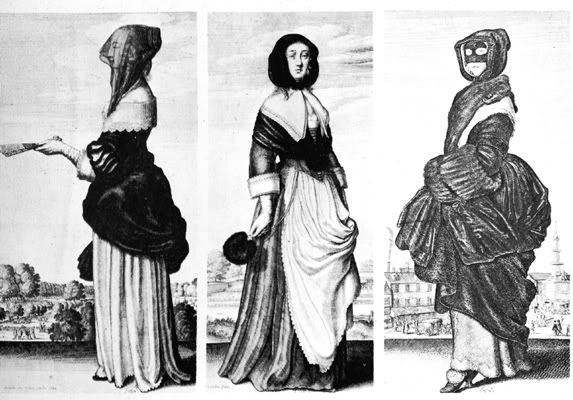
Much as I love historical romance (icky, I know!), I'm really glad I didn't live in the 17th century. Now of course, I get all the centuries wrong so don't think for one second that I'm a pro on this. I get the 16th, 17th and 18th centuries mixed up, just so you know. The point is, I'm glad to be a modern woman living in the modern age. I love my gadgets, my Turbolash vibrating mascara, my stiletto heels. I love how society, at least in most places, are more open and accepting of people from all backgrounds. That simply didn't happen in the earlier centuries. There was no such thing as "equality". Women were second-class citizens and had to act a certain way or they were excluded from society, ruined forever. I just can't imagine living all boxed-up like that; Had I lived in that period, I would've been hanged, drawn and quartered for being independent-minded and outspoken! Still, I find some parts of history so ridiculously interesting...

From this link. Fashion in the 17th century. "These women are pictured with some of the prominent accessories of the 17th Century. These include folding fans, and soft facial masks."
According to this link, back in the 17th century men and women rarely washed. They also took applying foundation to a whole new level by painting their faces so white and thick it almost looked like plaster.
The 17th century makeup included the use of powder. It was mixed with egg fiber and in such a way it was rendered on skin: the thicker, the better. The English queen Elizabeth I traced on a layer of powder on blue blood vessels to give the skin a translucent kind.Powder was also created from white chalk or lead, which, as you know, is very harmful. They also reddened their lips and cheeks excessively to contrast the whiteness of their powder. In this century, we've got "concealers" to hide scars and acne, but back in those days, people wore "beauty patches" to cover scars. From Vintage Connection:
...pieces of velvet or silk cut into the shape of stars, moons, hearts, and similar figures—were frequently applied to the face and body to cover smallpox scars, and similar marks. A “secret language” even developed through their use: A patch near the mouth meant you were flirtatious; one next to the right cheek signaled you were married; one on the left cheek announced you were engaged; one at the corner of the eye meant you were somebody’s mistress.This reminds me of my childhood days, when I was obsessed with scented stickers and I'd stick those little heart-shaped glittery ones near the corner of my eye or somewhere else on my face to look like a fairy princess! I can't imagine applying cut-out velvet anywhere on my face though. How the hell does that look like?? And if that wasn't silly enough, things progressively got worse during the 18th century. From the same website:
Makeup was heavier during the 18th century. Likewise, a rise in medical complications occurred—tooth decay, adverse skin conditions, and poisonings were often caused by the use of dangerous makeup. Lead and sulfur (for enhancing the cleavage), mercury (for covering blemishes), and white lead (for whitening the complexion) were frequent hindrances of the medical world.Mouse fur? No thanks. Lead and sulfur? You have got to be kidding me. Yes the 17th and 18th centuries make great backdrops for a romantic Hollywood film, but I am so thankful to be born in the 80s! I disco, baby!
Men, women, and even children wore makeup to some extent in order to achieve the fashionable white face with flaming red cheeks and lips. Eyebrows were accentuated with pencils,or concealed beneath false eyebrows made of mouse fur.

0 comments:
Post a Comment